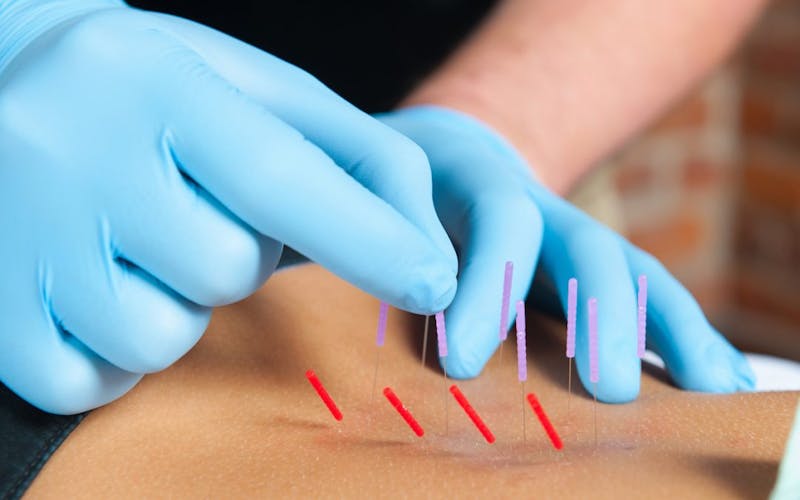Dry needling
Dry needling is a procedure in which needles are inserted through the skin to the target tissue to bring about a therapeutic effect. The technique uses a “dry”needle, one without medication or injection. The goal of the dry needling is to provide relief from pain or to improve range of motion by inactivating trigger points. Trigger points develop in muscle for various reasons including referred or local pain, inflammation, tissue injury or other causes.
A myofascial trigger point, also known as a knot in the muscle, is a group of muscle fibers which have shortened when activated but have not been able to lengthen back to a relaxed state after use. It is also sometimes called intramuscular stimulation or trigger point dry needling.
Practitioner inserts short, thin, stainless steel filiform needles into pressure points. Also called trigger points, these are tight areas or knots in the muscles. Filiform needles are fine, short, stainless steel needles that don’t inject fluid into the body. The needle may be placed deeply or superficially, for shorter or longer periods of time, depending on the type and duration of pain. The size of the needle could be short as 12.5mm or as long as 100mm. The needles are kept inserted for a span of 30 seconds to few minutes and then withdrawn and disposed properly.

How does dry needling work?
When a fine filament needle is inserted into the center of a myofascial trigger point, it stimulates a local twitch response (LTR), which triggers the contracted muscle fibers to relax by providing those fibers with fresh oxygen and nutrients. This, in turn, leads to the decompression of the local blood and nerve supply.
After treatment
Immediately after treatment patient may feel soreness in the area of the body that was Dry needled. Some patient may feel nauseous.
Benefits
Dry needling provides following benefits:
- Reduces muscular stiffness and pain
- Improves muscle contraction
Dry needling may also treat:
- Joint problems
- Jaw problem
- Migraine
- Whiplash
- Spinal dysfunction
Side effects
There are very rare side effects of dry needling. It may include-
- Organ puncture- It is very rare and may occur due to improper insertion of needle. Such as pneumothorax, caused by puncturing the lungs while inserting the needle in chest.
- Infection- If nonsterile needles are used, patient might be at risk for contracting bloodborne illnesses, infection, and diseases.
- Temporary soreness
- Bleeding & bruising
- Fatigue
DISCLAIMER
This web page provides general information and discussions about health, medicine and related subjects. The information and other content provided on this website, or in any linked materials, are not intended and should not be construed as medical advice, nor is the information a substitute for professional medical expertise or treatment.
The content is for information purpose only and is not a medical advice. Qualified doctors have gathered information from reputable sources; however Credence Medicure Corporation is not responsible for errors or omissions in reporting or explanations. No individual should use the information, resources and tools contained herein to self diagnose or self treat any medical condition.
If you or any other person has a medical concern, you should consult with your health care provider or seek other professional medical treatment. Never disregard professional medical advice or delay in seeking it because of something that have read on this blog or in any linked materials. If you think you may have a medical emergency, call your doctor or emergency services immediately.
The opinions and views expressed on this blog and website have no relation to those of any academic, hospital, health practice or other institution. Credence Medicure Corporation gives no assurance or warranty regarding the accuracy, timeliness or applicability of the content.
